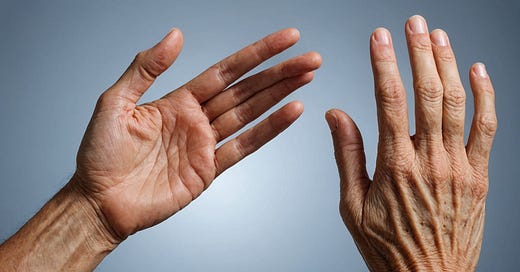Osteoarthritis is a common condition that affects the joints in the fingers and hands. It is characterized by a loss of cartilage between the joints.
Common symptoms include pain, stiffness, and the formation of bony growths. These growths are called Heberden's nodes on the end joints of the fingers, and Bouchard's nodes on the middle joints.
Other types of arthritis that can affect the hands and fingers include psoriatic arthritis, gouty arthritis, and rheumatoid arthritis.
Psoriatic arthritis can cause swelling of the entire digit, called "sausage finger," and nail pitting.
Gouty arthritis can mimic infection, and is associated with high levels of uric acid in the blood.
Rheumatoid arthritis is often polyarticular (affecting multiple joints), bilateral, and symmetrical, and can cause morning stiffness, pain, and swelling.
Self-Help Treatments for Arthritis in the Fingers and Hands
Movement is helpful. Movement can "oil" the joints and make the remaining cartilage healthier.
Strengthening muscles that control the hands can improve hand function and reduce pain.
Specific Exercises:
Mobilize finger joints by gently pushing each joint into flexion (bending) and extension (straightening).
Practice opposition by pinching the thumb to each fingertip, holding for five seconds, and then relaxing. This can be done in warm water for better results.
Improve grip strength by squeezing a towel, holding for 10 seconds, and repeating, or by doing fast grips and releases.
Strengthen extension by wrapping a rubber band around the fingers and thumb and opening the hand against the resistance.
Work on adduction and abduction by opening the fingers wide and then squeezing them shut.
Thumb-Specific Exercises
Trigger point release: Apply pressure to tender spots in the muscles around the thumb, holding for 30 seconds or until the pain eases.
Web space stretch: Open the thumb web space, then push the web spaces of both hands together, hold for 10 seconds and repeat.
Thumbs down stretch: Gently pull the thumb down toward the floor, holding for 10 seconds.
Devices:
Hand grip strengtheners and finger exercisers can help build hand and finger strength.
Paraffin wax baths can soothe and moisturize the hands.
Weighted silverware can make eating easier for those with grip issues.
Foam tubing grips can be added to kitchen tools, toothbrushes, and hairbrushes for easier use.
Electric can openers can reduce the pain of struggling to open cans.
Compression gloves can reduce swelling and pain.
Door knob cover grips can make turning doorknobs easier.
Wider-grip pens can reduce strain when writing.
Other helpful measures:
Splints and wraps can support finger joints.
Heat therapy can provide pain relief.
Dexterity exercises such as moulding putty, tying knots, or playing with a Rubik's Cube can improve function.
Adaptive tools such as rubber grips for pens and keys, or thickened cutlery can make everyday tasks easier.
Important Note: If you experience pain, stop the exercise. If your symptoms persist, consult with a hand therapist or specialist for tailored treatment.
Frequently Asked Questions About Hand and Finger Arthritis
What is osteoarthritis of the fingers and how does it differ from other types of arthritis? Osteoarthritis (OA) of the fingers is a degenerative joint condition characterized by the loss of cartilage between the small joints in the fingers and hands. This often leads to the formation of bony growths called Heberden's nodes at the distal joints (DIP) and Bouchard's nodes at the proximal joints (PIP) of the fingers. Unlike other types of arthritis like rheumatoid arthritis, which is an autoimmune and inflammatory condition, or psoriatic arthritis, which is associated with psoriasis and causes "sausage digits" and nail pitting, OA is primarily due to wear and tear of the joint cartilage. Gouty arthritis, another type, involves the build-up of uric acid in the joints, causing pain and swelling.
How can movement and strength exercises help manage arthritis symptoms in the hands and fingers? Movement is crucial for managing arthritis as it helps lubricate the joints and maintains the health of the remaining cartilage. Strengthening the muscles around the hands and fingers improves their function, reduces pain, and helps prevent muscle atrophy, which can worsen grip and dexterity. Exercises should focus on both range of motion and strengthening the specific muscles of the hand, rather than just grip strength.
What are some specific exercises recommended for hand and finger arthritis? Several exercises are commonly recommended:
Joint Mobilization: Gently pushing each finger joint into flexion (bending) and extension (straightening) helps maintain mobility.
Opposition: Pinching the thumb to each fingertip and holding helps maintain dexterity and fine motor control, which can be done in warm water for increased effect.
Grip Strength: Squeezing a towel or stress ball strengthens the grip, which can be done slowly and consistently or in fast reps.
Finger Extension: Using a rubber band to open the fingers against resistance strengthens the muscles responsible for opening the hand.
Adduction and Abduction: Opening the fingers wide and then squeezing them shut engages the muscles that control finger movement and strength
Thumb Trigger Point Release: Applying pressure to tender spots in the muscles around the thumb can release muscle tension and reduce pain around the thumb joint.
Web Space Stretch: Opening the thumb web space and gently pushing web spaces of both hands together improves the flexibility of the thumb.
Thumb Down Stretch: Gently pulling the thumb down towards the floor can provide relief and improve flexibility in that area.
What types of assistive devices are available to help with hand arthritis? There are numerous devices designed to help individuals manage arthritis:
Hand Grip Strengtheners and Finger Exercisers: These devices build strength and flexibility in the hands and fingers.
Paraffin Wax Baths: Soothe and moisturize the skin, and provide heat therapy to ease pain.
Weighted Silverware: Provides stability for eating with grip issues.
Foam Tubing Grips: Added to tools and utensils for easier gripping.
Electric Can Openers: Reduce the strain of opening cans.
Arthritis Compression Gloves: Reduce swelling and pain, and should be worn at night
Door Knob Cover Grips: Help with the turning motions that can be hard on arthritic joints
Wider-Grip Pens: Reduce strain during writing.
Besides exercises and devices, what are some other self-help strategies for managing hand and finger arthritis?
Splints and Wraps: Provide support to the finger joints and help to reduce flare ups, and can also cushion against irritating knocks and bumps.
Heat Therapy: Can be used via heat packs, lamps, or paraffin baths to alleviate pain, and even home versions like olive oil with warm water can achieve similar effects.
Dexterity Exercises: Activities like moulding putty, tying knots, or playing with a Rubik's cube enhance hand function and flexibility.
Adaptive Tools: Using tools with rubber grips, thickened handles, and adapted cutlery can ease everyday tasks.
What is De Quervain's tenosynovitis, and how is it managed? De Quervain's tenosynovitis is an overuse injury affecting the tendons on the thumb side of the wrist, causing pain. It is managed by:
Thumb Spica Splints: Rest the thumb and reduce stress on the muscles.
Massage: Gently massage the tight muscles in the forearm to reduce tension.
Direct Thumb Stretch: Gently bending the thumb down into the palm and angling the hand down for a mild stretch
Sub-Maximal Isometrics: Resisting thumb movement in the direction that activates the pain
Gripping Exercises: Squeezing rolled towels or stress balls
Hammer Exercises: Slowly lowering and raising a hammer for controlled wrist movement
Rubber Band Finger Extensions: Opening the hand against the band to increase finger range and strength
Theraband Flexbar exercises: Twisting and flexing the bar helps to engage the wrists and fingers in both directions
If self-help measures do not work, what are the next steps for managing hand arthritis? If self-help treatments do not provide relief, consider consulting a hand therapist or specialist. They may recommend tailored splints, specific exercise programs, or cortisone injections into painful joints. In some cases, surgical options like joint fusion or replacement may be considered.
What is the importance of maintaining hand flexibility and strength when suffering from arthritis, and what happens if this is not done? Maintaining hand flexibility and strength is essential because arthritis can lead to pain that causes individuals to use their hands less, leading to muscle atrophy. Without regular use, hand muscles weaken, resulting in dropping objects, issues gripping, and increased pain. Utilizing the various exercise regimens and assistive devices described in the sources is the best way to prevent this from happening.














Share this post